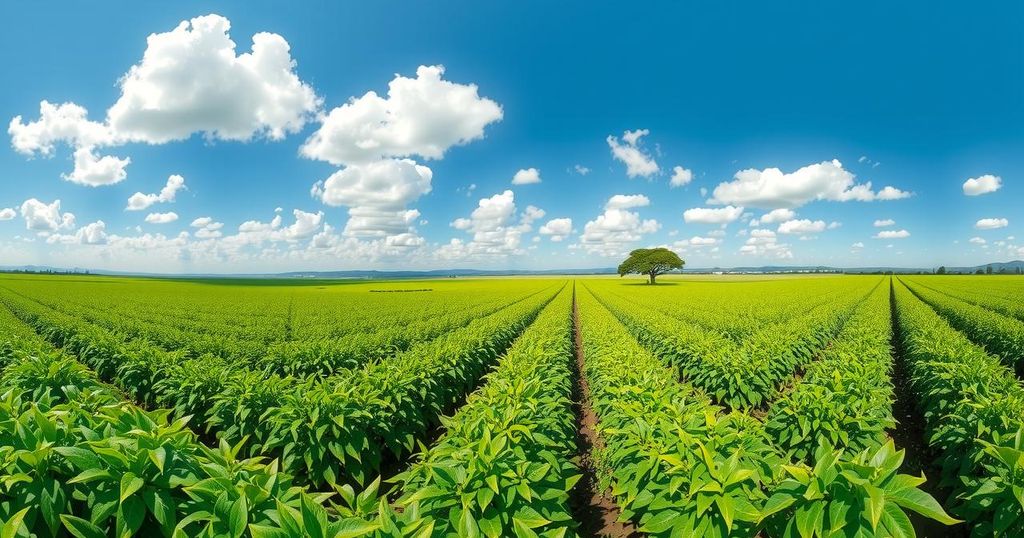Brazil is likely to increase agricultural exports to China as a result of U.S.-China trade tensions, impacting domestic food prices. The Brazilian government faces pressure to manage rising costs amid surging food inflation. Analysts predict significant agricultural production and export growth for Brazil, despite inflation challenges.
Brazil is poised to capture a larger share of China’s import market, driven by increasing demand for agricultural products as a result of the ongoing trade tensions between the United States and China. Higher export demand is anticipated to escalate domestic food prices in Brazil, which have already seen a rising trend for five consecutive months. As Brazilian officials prepare to meet with industry leaders, they face urgent pressure to address escalating costs.
The trade conflict initiated by U.S. President Donald Trump has created a notable opportunity for Brazilian agricultural exporters, allowing them to flourish at the expense of American farmers. Following recent U.S. tariffs on Chinese imports, China promptly retaliated, imposing its own tariff increases on American agricultural goods, thus incentivizing its importers to turn to Brazil for tariff-free options.
Brazil, recognized as the leading exporter of soybeans, cotton, beef, and chicken globally, is expected to boost its exports to China, particularly in the soybean sector, where it has already gained market share from U.S. farmers. Despite attempts by the U.S. to reclaim lost ground, China’s ongoing preference for Brazilian imports suggests a persistent shift towards Brazil for its agricultural needs.
Analysts from Santander foresee that the tensions between the U.S. and China could lead to an increased demand for grains and proteins from Brazil, impacting market dynamics significantly. Eduardo Vanin of Agrinvest noted that prices for Brazilian soybeans have recently surged to a seasonal high, indicating a tightening supply that may result from heightened demands from China, consequently raising prices in Brazil.
This uptick in food prices presents a challenge for Brazil’s President Luiz Inacio Lula da Silva, who has faced declining popularity due to rising living costs. Food and beverage prices have increased approximately 8% in 2024, continuing a trend that may pose challenges in the forthcoming months. The Brazilian central bank has indicated that surging meat prices contribute significantly to food inflation, leading to interest rate hikes in response.
As Brazilian firms strategize to tackle the implications of rising food prices, a meeting scheduled with food industry executives is expected to address potential solutions to the crisis. The adverse inflationary scenario parallels trends seen during 2018-2019 when Brazil saw heightened agricultural exports to China.
The newly implemented tariffs may not match the intensity of previous measures but are projected to enhance Brazil’s long-term diversification away from U.S. agricultural supplies. Market forecasts suggest a bright horizon for Brazil’s agribusiness with expectations for record output across key agricultural commodities.
Analysts predict a monumental soybean harvest exceeding 170 million metric tons for the 2024-2025 cycle, alongside record beef, poultry, and pork shipments. Ricardo Santin of the Brazilian meat industry expressed optimism regarding the global trade pivot, which is likely to yield favorable outcomes for Brazil’s prices and profitability in the meat sector, despite potential increases in feed costs.
Brazil stands at a pivotal juncture, with increased agricultural exports to China anticipated as a result of U.S.-China trade tensions, potentially inflating domestic food prices further. The Brazilian government faces significant challenges in managing rising food inflation and ensuring economic stability amidst these changes. However, the long-term outlook for Brazilian agribusiness appears robust, with projections of record crop yields and heightened exports. The situation demands proactive measures to alleviate consumer cost pressures while capitalizing on enhanced market opportunities.
Original Source: www.tradingview.com






